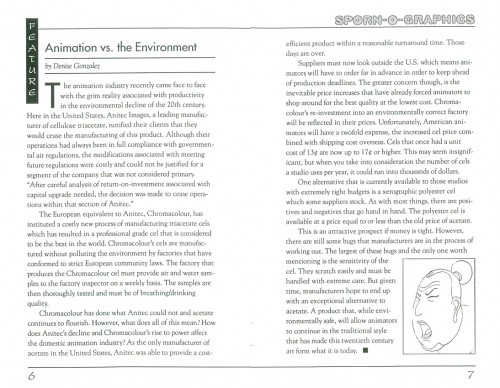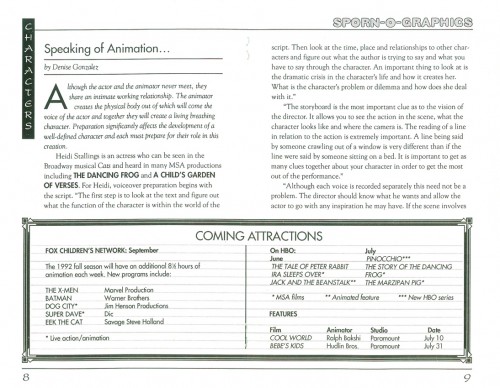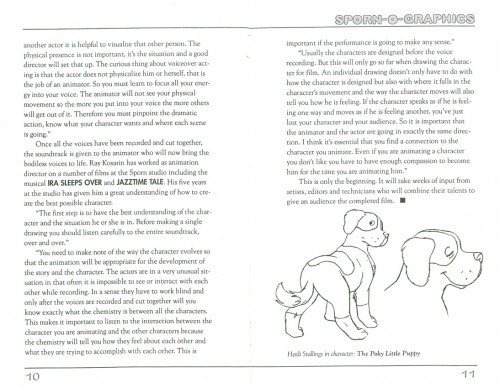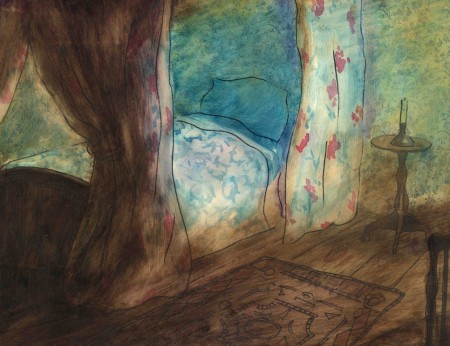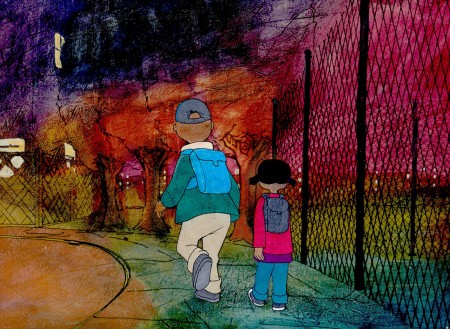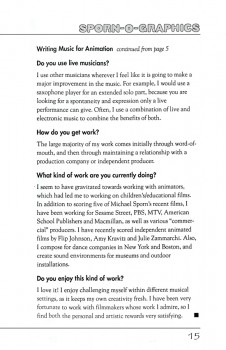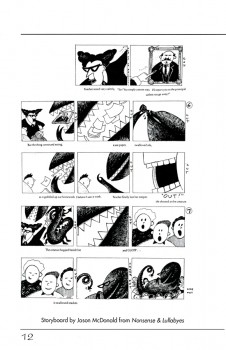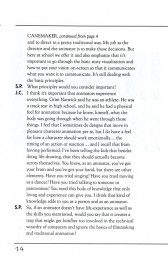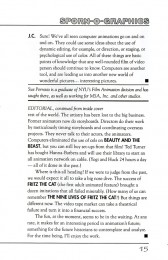Search ResultsFor "sporn-o"
Articles on Animation &SpornFilms 11 Dec 2010 08:45 am
Sporn-O-Graphics #3
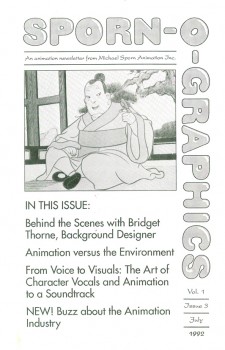 - In 1991, I’d started a small booklet publication, called Sporn-O-Graphics, that I sent out to about a thousand people on my mailing list. Basically, we were promoting ourselves by giving brief interviews and articles about the people in animation who had touched our films in some way. We focused on the films just about to air or were recently completed.
- In 1991, I’d started a small booklet publication, called Sporn-O-Graphics, that I sent out to about a thousand people on my mailing list. Basically, we were promoting ourselves by giving brief interviews and articles about the people in animation who had touched our films in some way. We focused on the films just about to air or were recently completed.
In a lot of ways, it was more fun having a hard copy magazine rather than a blog. It seemed a bit more permanent to have something in your hands, that stayed there until you were done with it.
The third issue, July 1992, concentrated on two specific films, NIGHTINGALE and THE POKY LITTLE PUPPY’S FIRST CHRISTMAS. Denise Gonzalez had just taken over editing the magazine and she conducted many of the interviews and articles for the issue. Her interview with art director/designer, Bridget Thorne, was the key piece, for me, in this issue. She also wrote a bit about voice acting for animation, concentrating on Heidi Stallings who had done the principal adult part for THE POKY PUPPY film.
I’ve posted these two pieces, here, to represent that issue.
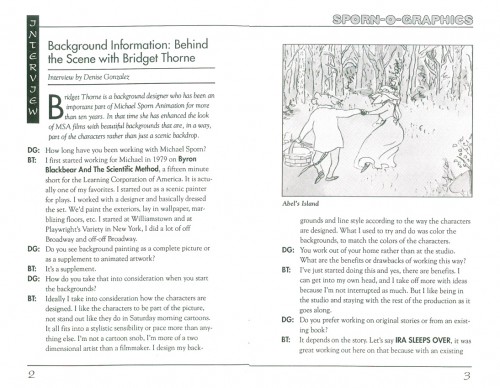 1
1(Click any image to enlarge.)
Here are links to issue #1 and issue #4
Animation &Animation Artifacts &Articles on Animation &SpornFilms 09 Dec 2009 08:09 am
Interviewing Bridget
- For a short while I produced a quarterly publication, called Sporn-O-Graphics, that promoted the work and the workers at Michael Sporn Animation, Inc. It was mailed free to about 1000 people on a list we’d put together. The idea was to talk about our films and the people who had made them. There were a total of six issues of this paper. I’ve posted a couple of the issues or more interesting bits in them on this blog, (here and here) and today I’d like to post an interview that was in one of the last issues. Bridget Thorne was as important to me as anyone who’s ever worked here. Denise Gonzalez also worked for me – at the time she edited and put together Sporn-O-Graphics.
Behind the Scenes with
Bridget Thorne
Interview by Denise Gonzalez
Bridget Thorne is a background designer who has been an important part of Michael Spom Animation for more than fifteen years. In that time she has enhanced the look of MSA films with beautiful backgrounds that are, in a way, part of the characters rather than just a scenic backdrop.
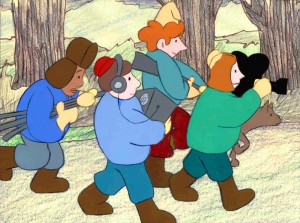 DG: How long have you been working with Michael Sporn?
DG: How long have you been working with Michael Sporn?
BT: I first started working for Michael in 1979 on Byron Blackbear And The Scientific Method, a fifteen minute short for the Learning Corporation of America. It is actually one of my favorites. I started out as a scenic painter for plays. I worked with a designer and basically dressed the set. We’d paint the exteriors, lay in wallpaper, marbleizing floors, etc. I started at Williamstown and at Playwright’s Variety in New York, I did a lot of off Broadway and off-off Broadway.
DG: Do you see background painting as a complete picture or as a supplement to animated artwork?
BT: It’s a supplement.
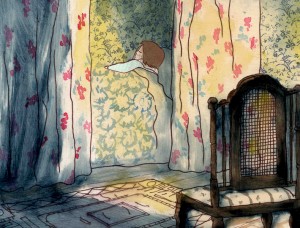 DG: How do you take that into consideration when you start the backgrounds?
DG: How do you take that into consideration when you start the backgrounds?
BT: Ideally, I take into consideration how the characters are designed. I like the characters to be part of the picture, not stand out like they do in Saturday morning cartoons. It all fits into a stylistic sensibility or pace more than anything else. I’m not a cartoon snob, I’m more of a two dimensional artist than a filmmaker. I design my backgrounds and line style according to the way the characters are designed. What I used to try and do was color the backgrounds, to match the colors of the characters. You work out of your home rather than at the studio. What are the benefits or drawbacks of working this way? I’ve just started doing this and yes, there are benefits. I can get into my own head, and I take off more with ideas because I’m not interrupted as much. But I like being in the studio and staying with the rest of the production as it goes along.
DG: Do you prefer working on original stories or from an existing book?
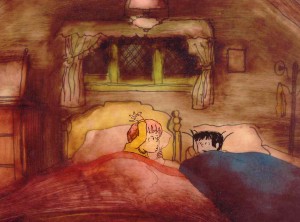 BT: It depends on the story. Let’s say IRA SLEEPS OVER, it was great working out here on that because with an existing story you have a style to imitate, and it is easy for a whole bunch of people to follow that when they’re all working in different places. So as far as production goes, that makes it easier. The great thing about original scripts is that they allow for an incredible amount of individual input. What do you take into consideration when designing the look of a film and what preparation is involved? It depends on the story. I tend to have a knee jerk reaction at first or an impulse. I have a Fine Arts background, and I tend to rely on painters. I find fine artists are more in tune stylistically with Michael’s films than the more hard-edged graphic cartoons. (Though I will look at Disney inspirational drawings.)
BT: It depends on the story. Let’s say IRA SLEEPS OVER, it was great working out here on that because with an existing story you have a style to imitate, and it is easy for a whole bunch of people to follow that when they’re all working in different places. So as far as production goes, that makes it easier. The great thing about original scripts is that they allow for an incredible amount of individual input. What do you take into consideration when designing the look of a film and what preparation is involved? It depends on the story. I tend to have a knee jerk reaction at first or an impulse. I have a Fine Arts background, and I tend to rely on painters. I find fine artists are more in tune stylistically with Michael’s films than the more hard-edged graphic cartoons. (Though I will look at Disney inspirational drawings.)
Then I look at the layouts and the character design, so I sort of work on intuition and impulse. Then I look at the existing elements and put those all together and come up with a design. As far as preparation goes, what I consistently do is make 5×4 sketches of design ideas. For ABEL’S ISLAND I did lots and lots of little paintings of winter and fall and spring.
First three illustrations pictured above:
1. BYRON BLACKBEAR AND THE SCIENTIFIC METHOD.
2. A CHILD’S GARDEN OF VERSES.
3. IRA SLEEPS OVER
DG: When designing the film do you take into consideration that this will be seen by a child?
BT: I’m not a cartoony person so I don’t think about that. I tend to think more — sometimes I run into trouble this way — I think of it in a frame and ideally what I really want is a balanced look on the screen. A lot of times that’s hard because what I see in front of me is so different when it is filmed.
DG: What do you consider to be the best example of your work thus far?
BT: I guess ABEL’S ISLAND. I was able to abstract a little. I wasn’t confined to chairs and bureaus. I was able to match the mood of the movie to the backgrounds. If Abel was in trouble, I could put colors that indicated that, or I could abstract it. If something was calm I could paint it calmly. Abstraction, or looseness, is more my personal style. This is true of Michael’s style, as well.
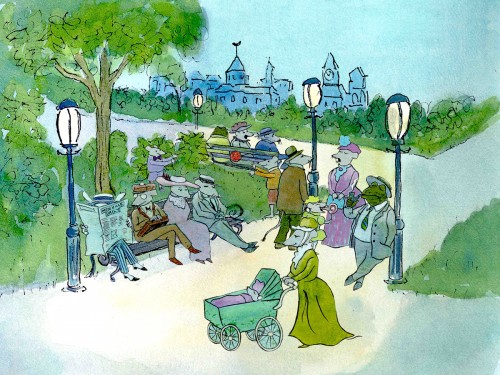
A scene toward the end of ABEL’S ISLAND.
DG: Have you ever worked on a film you couldn’t connect with?
BT: I’d say yes. It’s a hard question to answer off the top of my head. I sort of think of movies like they were kids; they are either noisy or funny or quiet or sad. They all have their own characteristics, and it is really the process of making the movie that attracts me to animation. I tend to have different feelings about each movie. But yes, sometimes a story irritates me or something comes in and it doesn’t suit my style or what I imagined. It can be very difficult. That’s an interesting thing about animation; there is really a sense of compromise; you are compromising all the time.
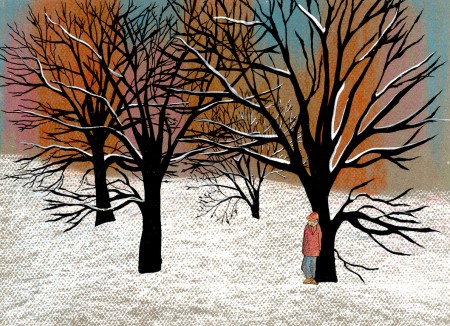
A scene of the narrator at the end of THE TALKING EGGS.
Articles on Animation &SpornFilms 01 May 2007 07:47 am
Sporn-O-Graphics #1
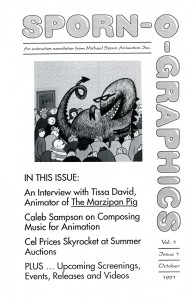 – In 1991, I’d started a small xeroxed publication that I sent out to about a thousand people on my mailing list. Basically, we were promoting ourselves by giving brief interviews and articles about the people in animation who had touched our films in some way.
– In 1991, I’d started a small xeroxed publication that I sent out to about a thousand people on my mailing list. Basically, we were promoting ourselves by giving brief interviews and articles about the people in animation who had touched our films in some way.
This first issue had as its focus the two half-hour films we’d done on poetry – Nonesense & Lullabyes: Nursery Rhymes and Nonesense & Lullabyes: Poems. These were two delightful films to work on, and I wanted to give them a bit of attention even though they were designed only for Home Video consumption. (We’re still trying to get back the rights from the now-defunct Live Entertainment to have them rereleased in dvd.)
The issue included a short interview with Tissa David who responded to questions by Esther McGowan, who edited the publication at the time. A non-animator asking curious questions.
(Click on any image to enlarge.)
The late Caleb Sampson wrote a short piece about writing film music for animation. Caleb did music for about 20 of my films.
Greg Perler gives a brief response to the differences of working at Disney’s studio as opposed to MSA. He had just moved to work on Beauty and the Beast as an Assistant Editor. (Greg recently is editing Disney’s Enchanted, due out later this year.)
The Tissa David interview:
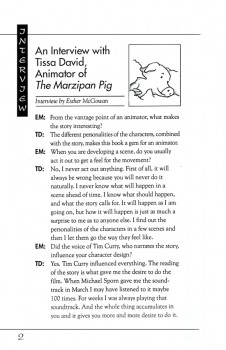 pg 2
pg 2 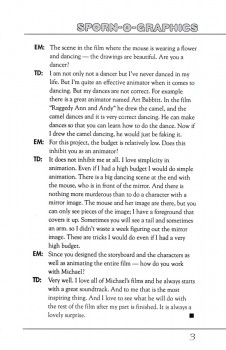 pg 3
pg 3
The Caleb Sampson article on music:
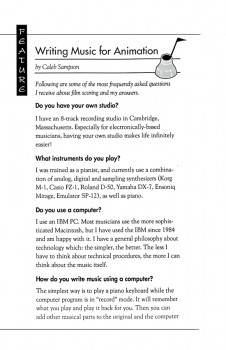 pg 4
pg 4 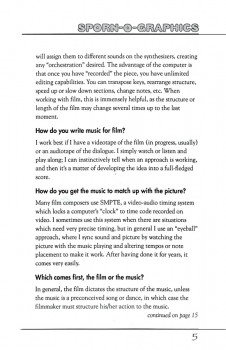 pg 5
pg 5
Stephen MacQuignon on Color Styling:
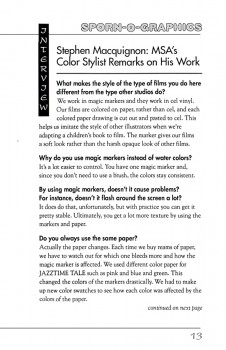 pg 13
pg 13 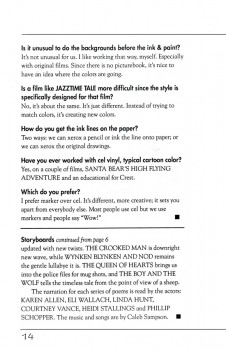 pg 14
pg 14
Greg Perler on editing here & there:
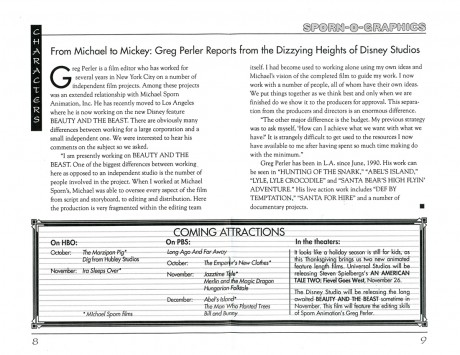 pgs 8 & 9
pgs 8 & 9
.
This issue was mailed with a cel from the half-hour shows, Nonesense & Lullabyes, and the response was a negative. Though there was no charge for the publication OR the cel, yet I received a letter back saying that the cels weren’t done with cel-vinyl, so they weren’t valuable! Oh, well. Sorry! I didn’t do that again.
Issue #4 previously appeared on this “Splog,” read it here if you’re interested.
Articles on Animation &SpornFilms 17 Mar 2007 08:34 am
Sporn-O-Graphics #4
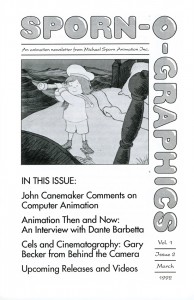 – In the early 1990′s we produced a little mimeographed magazine about animation, particularly animation within our studio. It was called Sporn-O-Graphics. About 1000 copies were sent out to a lot of people on our mailing list, no requests, no fees. We just sent them to whomever we wanted. We produced five issues of this publication, though only four were ever sent out.
– In the early 1990′s we produced a little mimeographed magazine about animation, particularly animation within our studio. It was called Sporn-O-Graphics. About 1000 copies were sent out to a lot of people on our mailing list, no requests, no fees. We just sent them to whomever we wanted. We produced five issues of this publication, though only four were ever sent out.
Since there are a couple of interesting bits in them, I’ve decided to post a couple of those interviews/articles on this site. For some of the pieces it’s re-releasing information; for others it’s fun looking back on some quaint, dated material.
In issue #4 we had two interviews:
Dante Barbetta is a first rate animator who worked at Paramount, NYIT and a lot of the commercial studios in NY. Some of his last animation was done for us on a couple of our half-hour shows.
(Click any image to enlarge.)
Denise Gonzalez, who put together this issue of Sporn-O-Graphics, interviews Dante. I wish this article had been more in-depth considering the wealth of knowledge Dante houses, but it’s good to give him any attention we can.
John Canemaker, the Oscar winning film maker, teacher and noted animation historian, is interviewed by Sue Perotto (a great animator and animation director, in her own right), John’s former student. The article focuses on the changing technology, and obviously is now dated, (it was done pre Toy Story) but I enjoyed rereading it and think you might as well.
This is Dante Barbetta ‘s interview:
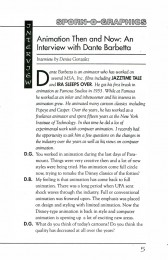 1
1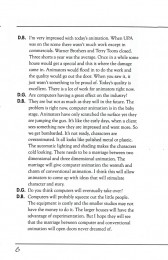 2
2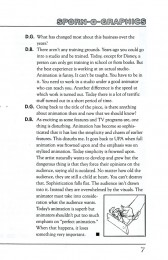 3
3
This is the John Canemaker interview:
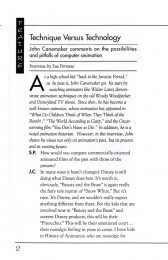 1
1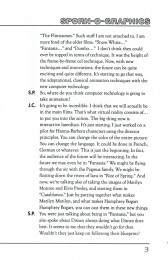 2
2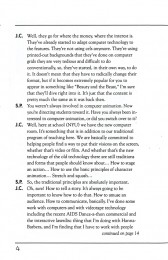 3
3
